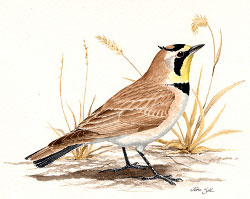Find a Bird - BBA1
Breeding Bird Atlas 1 Species Accounts
Horned Lark
Eremophila alpestris
Egg Dates
early March to July 16
Number of Broods
one or two

The Horned Lark enjoys a widespread, circumpolar range, breeding in North America from Alaska across Arctic Canada south to Mexico. One subspecies, praticola, the so-called “Prairie” Horned Lark, occurs in Massachusetts as a fairly common but locally distributed breeding bird. This race, best characterized by its pale plumage and whitish eye stripe, spread eastward into New England and markedly increased during the first half of the twentieth century. In Massachusetts, Horned Larks are most reliably found in the vicinity of coastal beaches, especially on the Cape and Islands, although suitable inland sites, particularly in the Connecticut River valley, include abandoned agricultural fields and pastures. The continued waning of agriculture and the loss of open land to forest regeneration and development have made sites such as golf courses and airports increasingly important to inland populations.
True harbingers of spring, local nesters return to the breeding grounds as early as late February but go largely undetected because they tend to mingle with the wintering or migrant “Northern” Horned Larks. This species’ exacting habitat requirements are for the most part barren and unproductive environments. They will tolerate only sparse vegetation, readily deserting a site if weeds, grass, or other cover grow too dense. Coastal residents prefer dry, sandy, or gravelly upper portions of beaches, especially where there is a preponderance of wrack or debris that serves as singing posts and shelters for nests. Flats among or behind barrier dunes where only sparse growths of Dunegrass or heather exist also seem to be favored nesting and foraging sites. Most of the Horned Lark’s diet is made up of various weed seeds, although a great variety of insects are also consumed during the warmer months.
During its nuptial flight, the male Horned Lark silently ascends to several hundred feet in altitude, where he begins his twittering pit-wit, wee-pit, pit-wee, wee-pit song while circling the nest site. This courtship flight is then abruptly halted with a dramatic plunge to earth on folded wings. A clear, high-pitched tsee-titi is the most frequent call note heard.
Horned Larks have a very protracted breeding season, nesting very early, with eggs laid in our area from the beginning of March to mid-July. From two to seven (usually four) pale greenish gray eggs, marked with fine brownish buff speckling, are deposited in a shallow scrape lined with fine grasses, plant down, and hair. The nest is usually placed in the shelter of a grass tuft, stone, or piece of driftwood. Three recent nests from eastern Massachusetts were located on beaches, 1 near a grass tuft, 1 near a pile of beach debris, and 1 near Beach Pea (CNR). A nest in Wellfleet contained one egg and three nestlings on June 30, and a Pittsfield nest held eggs on July 10 (CNR, EHF).
The long nesting season would allow for three broods, but generally nest losses to inclement weather and predators are high, and the species is frequently double brooded, readily replacing a lost clutch. Incubation, for 11 to 12 days, is solely the responsibility of the female. The altricial and downy young, fed by both parents, leave the nest at 9 to 12 days and fly at about 15 days. The range of dates for nestlings in the state is also extended, but there are relatively few specific records. A Dartmouth nest held two nestlings on April 28, the young at another nest fledged on May 7, a Monomoy nest had three large young on June 5, and a Wellfleet nest contained three nestlings (plus one egg) on June 30 (BOEM, CNR).
The well-camouflaged young, unable to fly at first, will often crouch motionless to avoid detection by potential predators. Again, the range of dates for fledged young is much greater than the few records would indicate. Adults and fledglings have been reported from May 25 to 28 (BOEM) and August 9 to 13 (EHF).
The breeding population generally departs soon after the nesting season for their winter quarters in the middle and southern United States. That population is replaced by more northerly breeding Horned Larks that arrive from Canada in October, many of which remain in Massachusetts for all or part of the winter season. At this time of the year, they are often encountered in stubble cornfields and salt marshes in large flocks that may include Lapland Longspurs and Snow Buntings.
Map Legend and Data Summary
Atlas 1 data collected from 1975-1979


Note: locally uncommon along coastal beaches; inland chiefly at airports and extensive cultivated fields
Richard S. Heil



